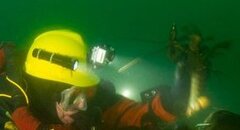I never use a tray, for the reason you pointed out, to always be able to use both of my hands. I have one BB 1800 light on a Goodman glove, mounted on one hand, and a small full-HD capable point and shoot camera in the other hand that is tightly clipped to a D-ring when not in use, and secured with a retractor when in use (retractors are evil, but I would argue, not nearly as much as a bulky setup one has to hold with both hands or mount on one's body). When shooting, the distance between both hands is sufficient to avoid backscatter, and it gives more flexibility in terms of positioning the light that often comes handy when trying to shoot some creature that's hidden deep in a crevice. I can easily hold my light at any distance or angle with respect to the camera, and even shoot the light through a different crevice than the one I aim my camera at. When in need, I can free either of my hands without losing either my light, or the camera. While swimming, the camera is held by two snap-bolts against D-rings such that it sticks to the body. The retractor can catch on things while in use, or when dropped, but it is very easy to break by twisting, and over the last few dozen dives I never had a problem with it. Managing two lights must be harder, but I'd still look into some ways of doing that, rather than mount the camera and lights on the helmet. Or leave one light behind... for me 1800 seems to suffice during the day, and on night dives I always have to crank it down. Just my 3 cents...




